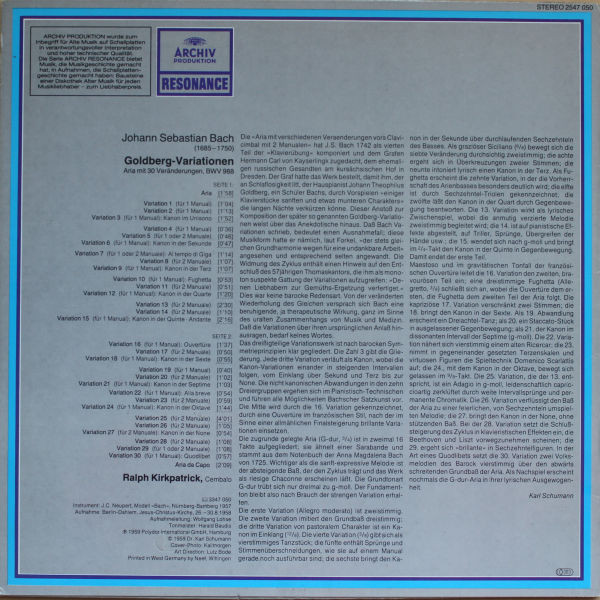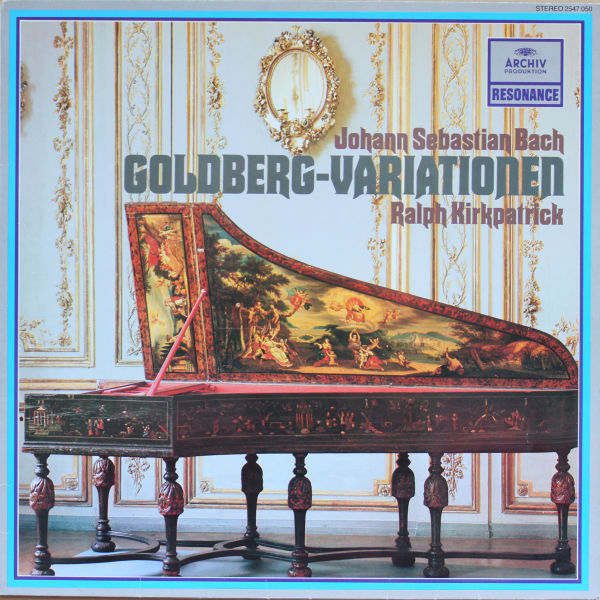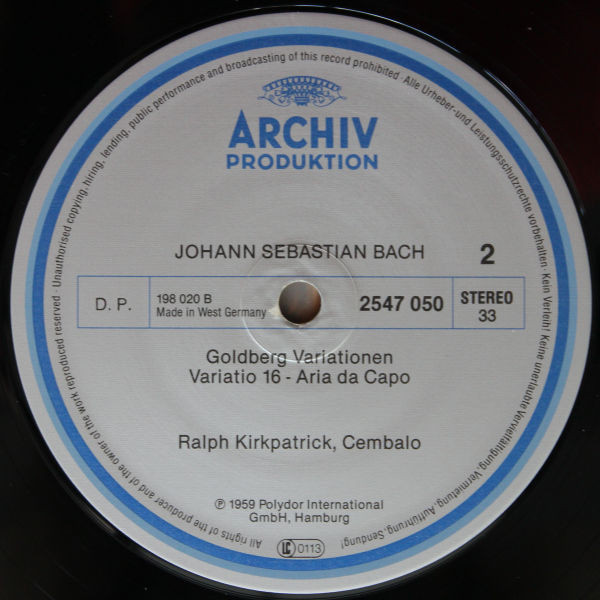Johann Sebastian Bach Ralph Kirkpatrick - Goldberg Variationen
Download
Filename: johann-sebastian-bach-ralph-kirkpatrick-goldberg-variationen.zip- MP3 size: 118.4 mb
- FLAC size: 1430.4 mb
Table of Contents
Tracks
| Track | Duration | Preview |
|---|---|---|
| Variation 17 (für 2 Manuale) | 0:50 | |
| Variation 1 (für 1 Manual) | 1:04 | |
| Variation 26 (für 2 Manuale) | 1:05 | |
| Variation 10 (für 1 Manual): Fughetta | 0:53 | |
| Variation 21 (für 1 Manual): Kanon in der Septime | 1:03 | |
| Variation 3 (für 1 Manual): Kanon im Unisono | 1:52 | |
| Aria da Capo | 2:09 | |
| Variation 29 (für 1 oder 2 Manuale) | 1:08 | |
| Variation 20 (für 2 Manuale) | 1:02 | |
| Variation 14 (für 2 Manuale) | 1:10 | |
| Variation 16 (für 1 Manual): Ouvertüre | 1:37 | |
| Variation 27 (für 2 Manuale): Kanon in der None | 0:54 | |
| Variation 4 (für 1 Manual) | 0:36 | |
| Variation 11 (für 2 Manuale) | 0:51 | |
| Variation 5 (für 1 oder 2 Manuale) | 0:46 | |
| Variation 9 (für 1 Manual) | 1:07 | |
| Aria | 1:58 | |
| Variation 22 (für 1 Manual): Alla breve | 0:54 | |
| Variation 25 (für 2 Manuale) | 4:01 | |
| Variation 23 (für 2 Manuale) | 0:59 | |
| Variation 8 (für 2 Manuale) | 1:07 | |
| Variation 24 (für 1 Manual): Kanon in der Oktave | 1:44 | |
| Variation 22 (für 1 Manual): Quodlibet | 0:57 | |
| Variation 19 (für 1 Manual) | 0:40 | |
| Variation 12 (für 1 Manual): Kanon in der Quarte | 1:20 | |
| Variation 15 (für 1 Manual): Kanon in der Quinte - Andante | 2:16 | |
| Variation 18 (für 1 Manual): Kanon in der Sexte | 0:55 | |
| Variation 2 (für 1 Manual) | 1:13 | |
| Variation 13 (für 2 Manuale) | 2:30 | |
| Variation 28 (für 2 Manuale) | 1:08 | |
| Variation 6 (für 1 Manual): Kanon in der Sekunde | 0:47 | |
| Variation 7 (für 1 oder 2 Manuale): Al tempo di Giga | 1:14 |
Video
Ralph Kirkpatrick (harpsichord) Johann Sebastian Bach: Goldberg Variationen, BWV 988
JS Bach: Goldberg Variations BWV 988 - Ralph Kirkpatrick, 1958 - Archiv 198 020 SAPM (SCORE)
Images




Catalog Numbers
2547 050Labels
Archiv ProduktionListen online
- ouvir online
- lyssna på nätet
- lytte på nettet
- kuunnella verkossa
- online anhören
- écouter en ligne
- online luisteren
- ascolta in linea
- escuchar en línea
Formats
- Vinyl
- LP
- Reissue
- Repress
- Stereo
Companies
| Role | Company |
|---|---|
| Recorded At | Jesus-Christus-Kirche, Berlin |
| Phonographic Copyright (p) | Polydor International GmbH |
| Manufactured By | PRS Hannover |
| Printed By | Neef |
Credits
| Role | Credit |
|---|---|
| Art Direction | Lutz Bode |
| Composed By | Johann Sebastian Bach |
| Cover | Kallmorgen |
| Photography By | Kallmorgen |
| Engineer | Harald Baudis |
| Harpsichord | Ralph Kirkpatrick |
| Recording Supervisor | Wolfgang Lohse |
| Sleeve Notes | Karl Schumann |
Notes
- Aria mit 30 Veränderungen, BWV 988
- Instrument: J.C. Neupert, Modell "Bach", Nürnberg-Bamberg 1957
- Aufnahme: Berlin-Dahlem, Jesus-Christus-Kirche, 26.-30.8.1958
- ℗ 1959 Polydor International GmbH, Hamburg
- Printed in West Germany by Neef, Wittingen
- PRS Hannover [no ink stamp]
Barcodes
- Label Code: LC 0113
- Rights Society: D.P.
- Matrix / Runout (Label side A): 198 020 A
- Matrix / Runout (Label side B): 198 020 B
- Matrix / Runout (Runout side A, stamped, variant 1): 198 020 A = 5 3 20
- Matrix / Runout (Runout side B, stamped, variant 1): 198 020 = 5 B 198 638 B 320
- Matrix / Runout (Runout side A, stamped, variant 2): 198 020 A = 4 198638 A 3 20 1 –
- Matrix / Runout (Runout side B, stamped [90°rotated], variant 2): 198 020 = 5 B 198 638 B 320 1 [1 A Z]
Comments
Related albums
Top Albums
ETrax - Volume 2
Monty Python - Monty Pythons The Meaning Of Life

John Ridout & Ross Self - Closer
John Coltrane Quintet Featuring Eric Dolphy - The 1961 Helsinki Concert
Nirvana - Under The Milky Way
Soul Puncherz Featuring Lauren Rochelle - Adrenaline Rush
Maximo Rodriguez Y Sus Estrellas - Manito y Maximon En New York
Various - The Greatest Rock And Roll Concert Ever
The Movieland Orchestra - The Latest Screen Super Library 最新映画全曲集
Böhse Onkelz - Von FFM Punx Zu Bunker Skins
Various - Outer Forms Vol2

Agoff - Swag For Sale 3
Bach was nothing if not industrious and disciplined, and his output of work was superhuman. And amidst this library of material penned by him, there emerge some gems of extraordinary and timeless beauty. And, certainly Goldberg Variationen, BWV 988 is one of these. And as rarefied precious stones must be cut and set with the utmost care and artistry, so too does a rarefied composition of music require the utmost care and artistry in its performance. Trying hard is not good enough. You must succeed in rendering these musical ideas on paper into sound that does justice to what the composer heard in his mind.
With Ralph Kirkpatrick we have just the stonecutter we need to render what Bach wrote on paper into a historically informed performance that sparkles with 18th century verve and panache. I neither need nor desire to hear any other recording of Goldberg. As a preeminent musicologist and scholar, Kirkpatrick’s playing of Bach’s keyboard works are guided by his thorough knowledge of high Baroque style. And his playing of the Harpsichord is not a mere afterthought of his scholarship. He is a master performer of the Harpsichord and Clavichord. This Archive Production recording is unequivocally the Gold standard for performance of this timeless masterpiece which Bach composed at the height of his power.
absolutely sublime this performer and the lute playing of the harpsichord is superb as well
https://youtu.be/1AtOPiG5jyk
The "Goldberg" Variations were first published in
1742 by Balthasar Schmid in Nürnberg under the
modest title: "Keyboard-practice, consisting of an
Aria with different variations for the harpsichord
with two manuals. Prepared for the enjoyment of
music-lovers by Johann Sebastian Bach, Polish
royal and Saxon electoral court-composer, director
and choir-master in Leipzig." The Aria appears
as a Sarabande in Anna Magdalena Bach's notebook
of the year 1725.
About the composition of these variations, Forkel
tells the following story, which, for all its doubtful
character, has permanently attached to them the
name of Bach's pupil, Johann Gottlieb Goldberg.
"For this model, upon which all sets of variations
should be formed (although for comprehensible
reasons not a single set has yet been thus made),
we have to thank the instigation of the former
Russian ambassador to the electoral court of
Saxony, Count Keyserlingk, who often stopped in
Leipzig and brought there with him the aforementioned
Goldberg, in order to have him given
musical instruction by Bach. The Count was
often ill and had sleepless nights. At such times,
Goldberg, who lived in his house, had to spend
the night in an antechamber, so as to play for
him during his insomnia. Once the Count
mentioned in Bach's presence that he would like
to have some clavier pieces for Goldberg, which
should be of such a smooth and somewhat lively
character that he might be a little cheered up
by them in his sleepless nights. Bach tought
himself best able to fulfil this wish by means
of variations, the writing of which he had until
then considered an ungrateful task on account
of the repeatedly similar harmonic foundation.
Thereafter the Count always called them his
variations. He never was tired of them, and for a
long time during sleepless nights he meant: 'Dear
Goldberg, do play me one of my variations.' Bach
was perhaps never so rewarded for one of his
works as for this. The Count presented him with
a golden goblet filled with 100 louis-d'or. Nevertheless,
even had the gift been a thousand times
larger, their artistic value would not yet have
been paid for."
Like an enormous passacaglia, the variations
reiterate the harmonic implications of the same
bass in thirty different forms. This fundamental
bass is never staded entirely in its most elemental
form not even in the Aria. But on this harmonic
skeleton and around it are constructed the variations,
each highly organized and composed of
independent thematic material. These follow one
another in a symmetrical grouping like the beads
of a rosary.
The form of the variations as a whole may lie
shown by comparison, as before, to that of a
rosary, or perhaps better explained by an architect)
lral analogy. Framed as if between two terminal
pylons, one formed by the Aria and the
first two ' variations, the other by the two penultimate
'variations and the Quodlibet, the variations
are grouped like the members of an
elaborate colonnade. The groups - are composed
of a canon and an elaborate two-manual arabesque,
enclosing in each case another variation of independent
character. Following upon the pylon-like
group which terminates this rhythmic procession,
the Aria repeated closes the great circle.
There are nine canons, at intervals successively
from the unison to the ninth, those at the fourth
and fifth in contrary motion, that at the ninth
without any independent third voice, such as
accompanies the others. Among the variable forms
are to be found a fughetta, a French overture,
florid slow movements, etc.
The Quodlibet mixes together the tunes of two
folk-songs:
. "Ich bin so lang nicht bei dir gewest.
Ruck her, ruck her, ruck her."
and:
"Kraut und Ruben haben mich vertrieben,
hatt' mein' Mutter Fleisch gekocht,
·so war' ich langer blieben.·
These might be translated thus:
"I've not been with you for so long,
Come closer, closer, closer."
and:
"Bee ts and spinach drove me far away.
Had my mother cooked some meat,
then I'd have stayed much longer.'
The following passage from the preface to my
edition of the Goldberg Variations, published by
G. Schirmer, New York, represents a kind of
writing which I feel should not ordinarily be indulged.
It was written nearly twenty-five years
before the . making of the present recording. Yet
in the intervening time, despite modifications in
the interpretation of a few variations, my sentiments
have not fundamentally changed.
"However much it is an act of impudence thus to
discuss something which is far too profound and
complex to be grasped in words, it seems necessary
to confess some of the feelings which
inevitably come with the playing of this music,
The Aria seems to foreshadow the spirit of the
whole work through the tenderness and calm with
which thp. solemnity of the fundamental bass is
clothed at its initial appearance.
The first variation stands like a festive gateway
leading to the inner world exposed in the following
three variations. These, like so many of the
canons and the Aria, have an unearthly pure
sweetness and a lyricism in every phrase that
makes one long to dissolve one's fingers, the
instrument, and one's whole self into three or
four singing voices. For a moment this quiet
lyricism is interrupted by the shining smooth
swiftness of the first arabesque variation (5). Then
comes a second canon of an almost nostalgic tenderness;
then a faraway scherzo (7) of the utmost lightness
and delicacy. The following arabesque and
canon return to a lyricism which is interrupted
by the brusque roughness of the Fughetta (10).
This is followed by the delicate network of the
third arabesque and the sunny canon at the fourth.
Then comes a flute aria (13) of a breath-taking
quiet pure joy. The humour of the fourth arabesque
makes even more striking the appearance
of the dark tragic canon at the fifth which ends
the first half of the variations,
The second half opens with a majestic French
Overture (16), followed by one of the lightest
of the arabesque variations. In the sixth canon
and the lute-variation (19) we return to a lyric
sweetness like that of the beginning, even more
peaceful. Another scherzo arabesque contrasts
with the sombre seventh canon, which in turn
joins on to the alla breve variation (22). This, for all
its quicker tempo, transforms the chromatic pathos
of the canon into that kind of serene chastened
joy which follows pain. In the seventh arabesque
we burst forth in the most unrestrained exuberant
joy, which is tranquillized in the gentle rocking
of the canon at the octave. Again we are interrupted
to be carried to even greater tragic heights
on the waves of a quiet yet irresistibly passionate
aria. From the eighth arabesque (26) on, the variations
mount through a sprightly canon, glittering
trills (28), and waltz-like bravura (29) to the final
jubilant climax in the Quodlibet (30), upon which
the repetition of the Aria falls like a benediction.
But for all their lyricism and tragic passion and
exuberance, the Aria and the Variations seem of
a divine substance entirely refined and purified
.of anything personal or ignoble, so that in plaYing
them on seems only the unworthy mouthpiece of
a higher voice.
But how Bach himself in pious humility would
ridicule these high-sounding words of ours with
a wry face and with god-like laughter:
'Kraut und Ruben .. : " Ralph Kirkpatrick
I] Uber Johann Sebastian Bachs Leben, Kunst und Kunstwerke,
IX (1802).